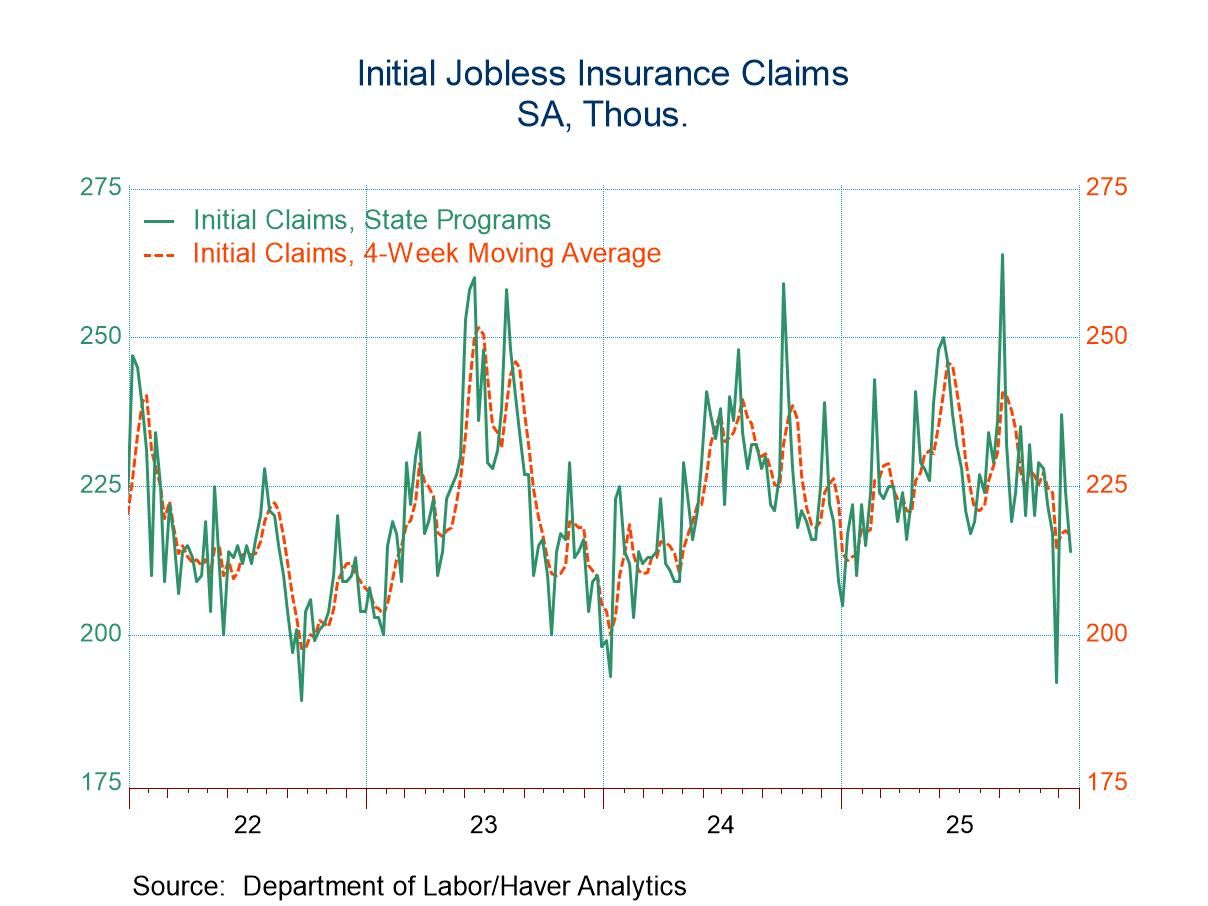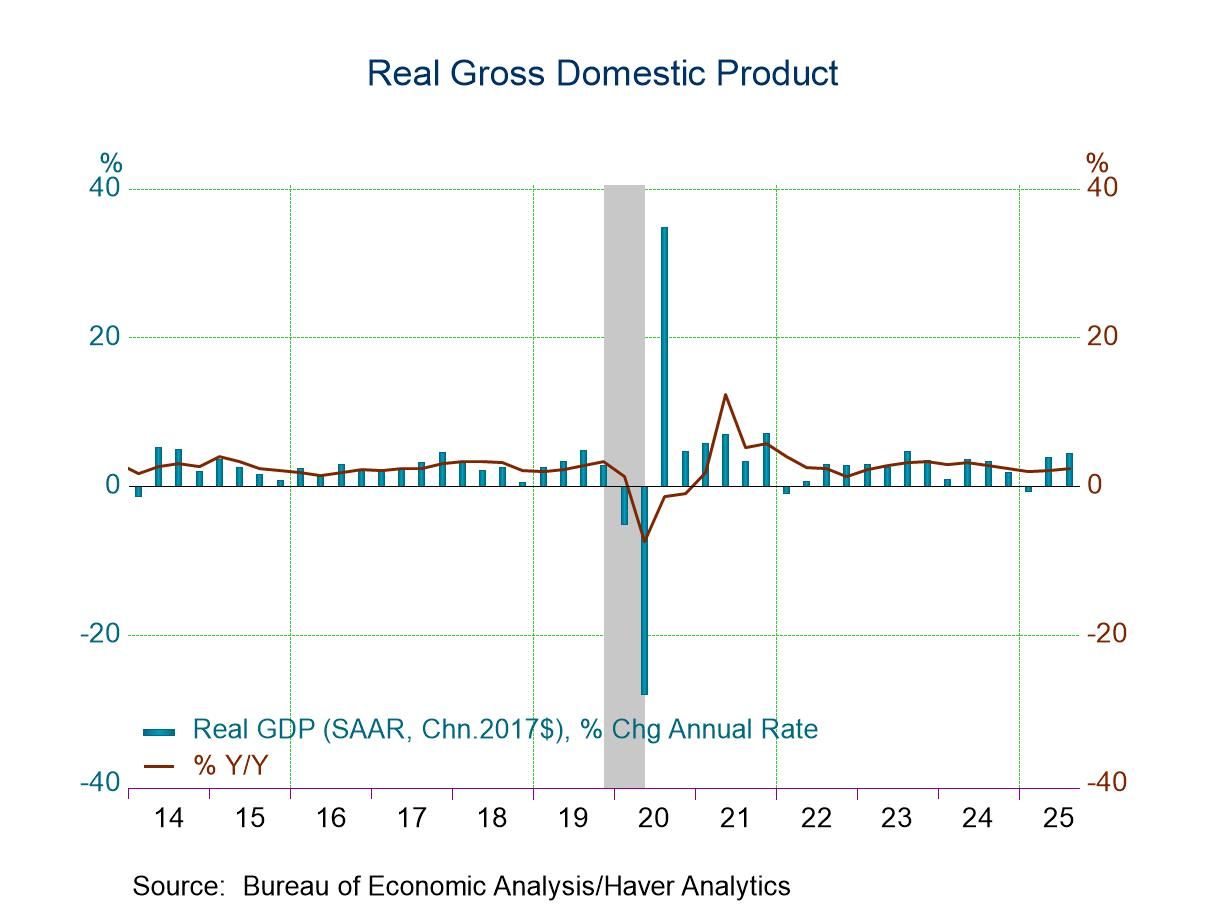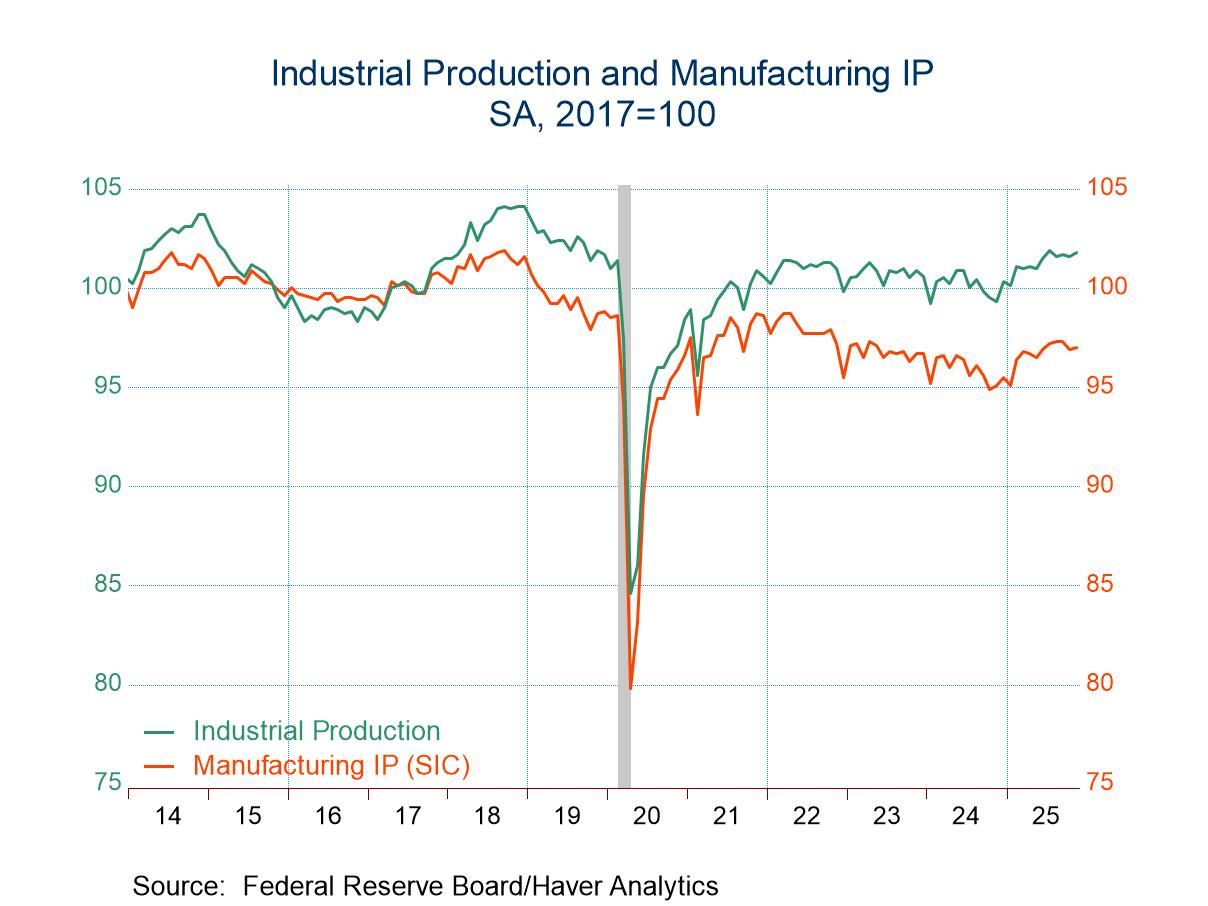U.S. GDP Growth in Q1’24 Is Revised Lower; Corporate Profits Ease
by:Tom Moeller
|in:Economy in Brief
Summary
- Growth remains slowest since mid-2022.
- Inventories & foreign trade subtract slightly more from growth.
- Moderate rise in domestic final demand gain is lessened.
- Acceleration in price index growth is little changed.


Real GDP grew 1.3% (SAAR) in Q1’24 in the second estimate, revised from 1.6% in the advance estimate. It follows a 3.4% gain in Q4’23 and a 4.9% Q3’23 rise. A 1.4% increase had been expected in the Action Economics Forecast Survey. Real GDP grew 2.9% on a Q1/Q1 basis after a 3.1% rise in 2023 and a 0.7% gain in 2022.
Before-tax corporate profits with IVA & CCA dipped 0.6% last quarter (+7.2% y/y) after rising 4.1% in Q4. Financial sector earnings rose 16.1% (6.9% y/y) following a 1.3% Q4 improvement. Nonfinancial sector profits declined 4.7% (+7.0% y/y) after rising 5.9% in Q4 while foreign sector profits rose 3.8% (8.4% y/y) after falling 1.7% in Q4. After-tax earnings without IVA & CCA increased 3.2% (10.9% y/y), rising for five consecutive quarters.
The contributions to GDP growth from the changes in business inventories and international trade were lessened. Inventories subtracted 0.45 percentage point from growth last quarter, revised -0.35, following a 0.47 point subtraction in Q. Net exports subtracted 0.89 percentage point, revised from 0.86 after adding 0.25 percentage point in Q4. Exports grew 1.2% (0.4% y/y), revised from 0.9% which followed a 5.0% Q4 rise. Imports strengthened a little-revised 7.6% (1.5% y/y) after rising 2.2% in Q4.
Growth in real final sales to domestic purchasers of 2.5% (2.9% y/y) was revised from 2.8% and followed two quarters of 3.5% gain. Personal consumption expenditures rose 2.0% (2.3% y/y), revised from 2.5% after a 3.3% increase in Q4, adding 1.3 percentage points to Q1 growth. Durable goods spending posted a bigger decline of 4.1% (+1.3% y/y) last quarter following a 3.2% gain. Motor vehicle expenditures fell 13.4% (-6.4% y/y), revised from -9.0%, after declining 1.7%. Furniture & appliance buying rose 0.5% (1.9% y/y), revised from 4.0% after a 1.7% gain in Q4. Recreational goods & vehicle purchases fell a little-changed 2.4% (+8.1% y/y) after strengthening 7.5% in Q4.
Nondurable goods outlays eased 0.6% (+1.7% y/y), revised from no change following 2.9% growth in Q4. Apparel outlays rose a lessened 3.6% (1.4% y/y) after a 3.4% increase while food & beverage spending rose a reduced 0.1% (0.9% y/y) following a 0.8% gain. Outlays on gasoline & other energy products declined a lessened 8.9% (+0.6% y/y) after rising 4.3% in Q4.
Spending on services increased a minimally-changed 3.9% last quarter (2.6% y/y) after a 3.4% gain. Housing & utilities outlays rose 1.3% both q/q and y/y after a 0.1% Q4 improvement. Health care purchases rose an increased 6.5% (4.8% y/y) following a 7.8% gain. Transportation services outlays growth of 6.1% (3.7% y/y) was revised from 4.6%, improved from a 4.2% Q4 rise. Restaurant & hotel accommodations fell 3.2% (+2.2% y/y), revised from -2.0% after gaining 6.5% in Q4, while growth in recreation outlays jumped 4.3% (2.1% y/y), revised from 4.8%, after a 0.4% rise in Q4.


Business fixed investment increased 3.3% (4.0% y/y), revised from 2.9% last quarter, following a 3.8% Q4 rise. Spending on nonresidential structures rose 0.4% (9.4% y/y), after a 0.1% (+9.4% y/y) slip after surging 10.9% in Q4. Equipment investment increased 0.3% (0.5% y/y), revised from 2.1% after falling 1.1%. Information processing investment strengthened 6.2% (0.8% y/y), revised from 12.2% following an 11.4% rise, while industrial equipment outlays grew 12.9% (0.4% y/y), revised from 17.8%, after holding steady in Q4. Transportation equipment spending offset these gains and weakened 22.9% (-0.4% y/y), revised from -25.6%, about as they did in Q4. Investment in intellectual property products increased 7.9% (4.2% y/y), revised from 5.4% after a 4.3% Q4 rise.
Residential structures investment surged 15.4% (5.5% y/y) in Q1, revised from 13.9%, adding to two consecutive quarters of firm increase.
Government spending increased a minimally revised 1.3% (3.8% y/y), accounting for 0.23 percentage points of GDP growth, after a 4.6% rise. Federal government spending eased 0.7% (+2.4% y/y), revised from -0.2% following a 2.4% increase. State & local government spending grew 2.6% (4.6% y/y), revised from 2.0% after a 6.0% Q4 rise.
The GDP price index rose 3.0% (2.4% y/y), revised from 3.1%, last quarter after a 1.6% Q4 gain. The rise compared to an expected 3.1% gain. The PCE price index increased a minimally revised 3.3% (2.5% y/y) after a 1.8% rise. The PCE price index excluding food and energy rose a lessened 3.6% (2.8% y/y) after increasing 2.0% for two straight quarters. The PCE goods price index fell an unrevised 0.5% (-0.2% y/y) after falling 1.4% in Q4 and services prices rose a minimally-changed 5.3% (3.9% y/y), after a 3.4% rise. The PCE services price index less energy & housing rose 4.9% (3.5% y/y), revised from 5.1% after a 2.6% rise.
The business fixed investment price index rose an unrevised 1.4% (1.1% y/y) following a 2.0% gain. The residential investment price index improved 0.1% (2.0% y/y), revised from 0.6% following two quarters of roughly 4.0% increase. The government spending price index rose 4.1% (2.5% y/y), revised from 3.8% after rising 1.9% in the fourth quarter.
The GDP data can be found in Haver’s USECON and USNA databases. USNA contains virtually all of the Bureau of Economic Analysis detail in the national accounts. The Action Economics consensus estimates can be found in AS1REPNA.


Tom Moeller
AuthorMore in Author Profile »Prior to joining Haver Analytics in 2000, Mr. Moeller worked as the Economist at Chancellor Capital Management from 1985 to 1999. There, he developed comprehensive economic forecasts and interpreted economic data for equity and fixed income portfolio managers. Also at Chancellor, Mr. Moeller worked as an equity analyst and was responsible for researching and rating companies in the economically sensitive automobile and housing industries for investment in Chancellor’s equity portfolio. Prior to joining Chancellor, Mr. Moeller was an Economist at Citibank from 1979 to 1984. He also analyzed pricing behavior in the metals industry for the Council on Wage and Price Stability in Washington, D.C. In 1999, Mr. Moeller received the award for most accurate forecast from the Forecasters' Club of New York. From 1990 to 1992 he was President of the New York Association for Business Economists. Mr. Moeller earned an M.B.A. in Finance from Fordham University, where he graduated in 1987. He holds a Bachelor of Arts in Economics from George Washington University.






